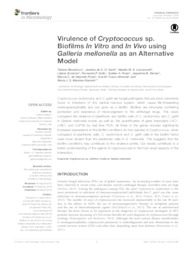Virulence of Cryptococcus sp. biofilms in vitro and in vivo using Galleria mellonella as an alternative model.
Virulence of Cryptococcus sp. biofilms in vitro and in vivo using Galleria mellonella as an alternative model.
Autoria: BENADUCCI, T.; SARDI, J. de C. O.; LOURENCETTI, N. M. S.; SCORZONI, L.; GULLO, F. P.; ROSSI, S. A.; DERISSI, J. B.; PRATA, M. C. de A.; FUSCO-ALMEIDA, A. M.; MENDES-GIANNINI, M. J. S.
Resumo: Cryptococcus neoformans and C. gattii are fungal pathogens that are most commonly found in infections of the central nervous system, which cause life-threatening meningoencephalitis and can grow as a biofilm. Biofilms are structures conferring protection and resistance of microorganism to the antifungal drugs. This study compared the virulence of planktonic and biofilm cells of C. neoformans and C. gattii in Galleria mellonella model, as well as, the quantification of gene transcripts LAC1, URE1, and CAP59 by real time PCR. All three of the genes showed significantly increased expressions in the biofilm conditions for two species of Cryptococcus, when compared to planktonic cells. C. neoformans and C. gattii cells in the biofilm forms were more virulent than the planktonic cells in G. mellonella. This suggests that the biofilm conditions may contribute to the virulence profile. Our results contribute to a better understanding of the agents of cryptococcosis in the host-yeast aspects of the interaction.
Ano de publicação: 2016
Tipo de publicação: Artigo de periódico
Unidade: Embrapa Gado de Leite
Palavras-chave: Biofilms, Cryptococcus sp
Observações
1 - Por padrão são exibidas publicações dos últimos 20 anos. Para encontrar publicações mais antigas, configure o filtro ano de publicação, colocando o ano a partir do qual você deseja encontrar publicações. O filtro está na coluna da esquerda na busca acima.
2 - Para ler algumas publicações da Embrapa (apenas as que estão em formato ePub), é necessário ter, no celular ou computador, um desses softwares gratuitos. Sistemas Android: Google Play Livros; IOS: iBooks; Windows e Linux: software Calibre.
Acesse outras publicações
Acesse a Base de Dados da Pesquisa Agropecuária (BDPA) para consultar o acervo completo das bibliotecas da Embrapa.

